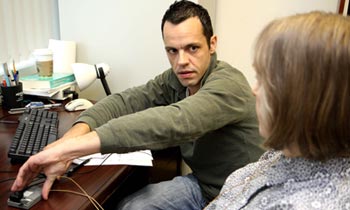Kostas Kokkinakis, a postdoctoral research associate in electrical engineering at The University of Texas at Dallas, is working to change that through a $225,000 project that could "greatly benefit the overall quality of life for a large number of cochlear implant users," he said.

Kostas Kokkinakis, Ph.D., works with a participant in the three-year study under way.
The so-called binaural hearing that comes from having two ears is intelligent in ways that we might not generally think about. Especially in aurally complex settings such as a cocktail party or a basketball game, where we're able to make sense of what we hear in part because of the way our ears do the work of an audio engineer, mixing and unmixing the variety of sounds in a way that helps us make sense of them.
"Even when fitted with two cochlear implant devices, it is often difficult to distinguish between the sounds you want to hear and those that you do not," said Dr. Kokkinakis, who received his Ph.D. in electrical engineering in 2005 from the University of Liverpool before coming to UT Dallas. "This means that people will generally avoid putting themselves in situations and environments where it is a struggle to hear and in which they feel uncomfortable. In this work we aim to use cutting-edge intelligent digital sound technology and various multi-microphone speech-processing strategies to improve speech understanding in noisy social settings and reverberant environments."
Key to the project is a technique called blind source separation, or BSS, that can be applied to cochlear implant devices that each have either one or two microphones for audio input.
"BSS can efficiently capitalize on the spatial cues present in the mixtures of the audio signals received by the microphones and essentially use that information to spatially separate the target audio from background noise," Dr. Kokkinakis said. "The working hypothesis is that upon spatially segregating the target speech signal from the interfering sounds, listeners will be able to benefit from a substantial increase in speech recognition."
Forty bilateral cochlear implant listeners will participate in the three-year study.
Dr. Kokkinakis came to UT Dallas in 2005 to work on multi-microphone signal-processing techniques under the supervision of Philip Loizou, a professor of electrical engineering and director of the Cochlear Implant and Speech Processing Lab in the Erik Jonsson School of Engineering and Computer Science at UT Dallas. Cochlear implant research by Dr. Kokkinakis and Dr. Loizou will be featured in an upcoming article in Hearing Health magazine (www.drf.org/magazine/).
Cochlear implant technology has developed rapidly since first coming into widespread use about 20 years ago. More than 112,000 people worldwide had received cochlear implants as of December 2006, including more than 15,000 children in the United States alone, according to the U.S. Food and Drug Administration.
This project is supported by funding from the National Institute on Deafness and Other Communication Disorders of the National Institutes of Health. More information on cochlear implants is available from the institute at https://www.nidcd.nih.gov/health/hearing/coch.asp and from Dr. Loizou's lab at utdallas.edu/~loizou/cimplants.
About UT Dallas
Located at the convergence of Richardson, Plano and Dallas in the heart of the complex of major multinational technology corporations known as the Telecom Corridor, The University of Texas at Dallas enrolls more than 14,500 students. The school's freshman class traditionally stands at the forefront of Texas state universities in terms of average SAT scores. The University's Erik Jonsson School of Engineering and Computer Science is in the final stages of a $240 million growth initiative that includes a new state-of-the-art 192,000-square-foot interdisciplinary research building. For more information about UT Dallas, please visit utdallas.edu.

